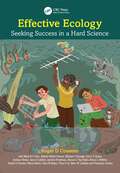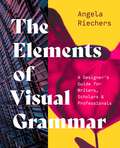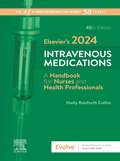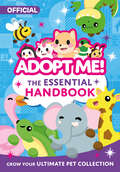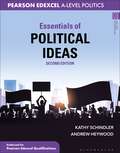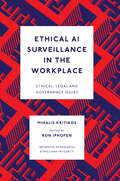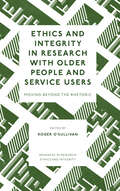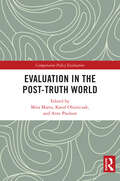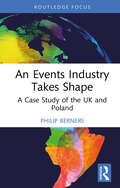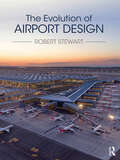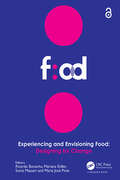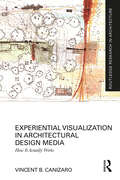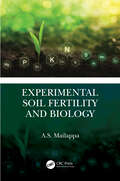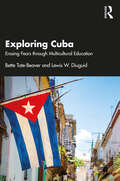- Table View
- List View
Effective Ecology: Seeking Success in a Hard Science
by Roger D. CousensEcology is one of the most challenging of sciences, with unambiguous knowledge much harder to achieve than it might seem. But it is also one of the most important sciences for the future health of our planet. It is vital that our efforts are as effective as possible at achieving our desired outcomes. This book is intended to help individual ecologists to develop a better vision for their ecology – and the way they can best contribute to science. The central premise is that to advance ecology effectively as a discipline, ecologists need to be able to establish conclusive answers to key questions rather than merely proposing plausible explanations for mundane observations. Ecologists need clear and honest understanding of how we have come to do things the way we do them now, the limitations of our approaches, our goals for the future and how we may need to change our approaches if we are to maintain or enhance our relevance and credibility. Readers are taken through examples to show what a critical appraisal can reveal and how this approach can benefit ecology if it is applied more routinely.Ecological systems are notable for their complexity and their variability. Ecology is, as indicated by the title of this book, a truly difficult science. Ecologists have achieved a great deal, but they can do better. This book aims to encourage early-career researchers to be realistic about their expectations: to question everything, not to take everything for granted, and to make up their own minds.
Effective Ecology: Seeking Success in a Hard Science
by Roger D. CousensEcology is one of the most challenging of sciences, with unambiguous knowledge much harder to achieve than it might seem. But it is also one of the most important sciences for the future health of our planet. It is vital that our efforts are as effective as possible at achieving our desired outcomes. This book is intended to help individual ecologists to develop a better vision for their ecology – and the way they can best contribute to science. The central premise is that to advance ecology effectively as a discipline, ecologists need to be able to establish conclusive answers to key questions rather than merely proposing plausible explanations for mundane observations. Ecologists need clear and honest understanding of how we have come to do things the way we do them now, the limitations of our approaches, our goals for the future and how we may need to change our approaches if we are to maintain or enhance our relevance and credibility. Readers are taken through examples to show what a critical appraisal can reveal and how this approach can benefit ecology if it is applied more routinely.Ecological systems are notable for their complexity and their variability. Ecology is, as indicated by the title of this book, a truly difficult science. Ecologists have achieved a great deal, but they can do better. This book aims to encourage early-career researchers to be realistic about their expectations: to question everything, not to take everything for granted, and to make up their own minds.
The Elements of Visual Grammar: A Designer's Guide for Writers, Scholars, and Professionals (Skills For Scholars Ser.)
by Angela RiechersA color-illustrated introduction to the basic principles of visual language that every content creator and consumer needs to knowThe right images capture attention, pique curiosity, and inspire viewers to stick around long enough to read any accompanying text. Nearly everyone today needs to use or understand images in communications of all kinds, from the most formal professional publication to the most casual social media post, and knowing the basics of visual language is essential for content creators and consumers alike. However, most people aren’t taught visual grammar unless they go into art- or design-related fields. The Elements of Visual Grammar explains image use in any media in practical terms for writers, scholars, and other professionals. Award-winning art director and design professor Angela Riechers offers a flexible set of principles and best practices for selecting images that work—and using them in the most persuasive way. The result is an indispensable guide for anyone who wants to learn how to work more successfully with images and words.Features more than 200 color illustrations—drawn from a wide range of styles, media, and eras—that demonstrate the principles of visual grammar and how images can support and enhance written contentDefines and illustrates the basic elements of images, describes how images function within text regardless of media, and explains how to choose images and integrate them with textIntroduces the practical, cultural, conceptual, and scientific factors that influence image useAnalyzes images by function and describes ways to employ symbolism, synecdoche, allegory, metaphor, analogy, and iconography
The Elements of Visual Grammar: A Designer's Guide for Writers, Scholars, and Professionals (Skills For Scholars Ser.)
by Angela RiechersA color-illustrated introduction to the basic principles of visual language that every content creator and consumer needs to knowThe right images capture attention, pique curiosity, and inspire viewers to stick around long enough to read any accompanying text. Nearly everyone today needs to use or understand images in communications of all kinds, from the most formal professional publication to the most casual social media post, and knowing the basics of visual language is essential for content creators and consumers alike. However, most people aren’t taught visual grammar unless they go into art- or design-related fields. The Elements of Visual Grammar explains image use in any media in practical terms for writers, scholars, and other professionals. Award-winning art director and design professor Angela Riechers offers a flexible set of principles and best practices for selecting images that work—and using them in the most persuasive way. The result is an indispensable guide for anyone who wants to learn how to work more successfully with images and words.Features more than 200 color illustrations—drawn from a wide range of styles, media, and eras—that demonstrate the principles of visual grammar and how images can support and enhance written contentDefines and illustrates the basic elements of images, describes how images function within text regardless of media, and explains how to choose images and integrate them with textIntroduces the practical, cultural, conceptual, and scientific factors that influence image useAnalyzes images by function and describes ways to employ symbolism, synecdoche, allegory, metaphor, analogy, and iconography
Elsevier’s 2024 Intravenous Medications - E-Book: A Handbook for Nurses and Health Professionals
by Shelly Rainforth CollinsNEW! Drug monographs for 8 newly approved drugs by the FDA include the most current information. NEW! Updates on drug uses, interactions, precautions, alerts, and more are included throughout the guide to reflect changes to existing medications. NEW! Information on preparation and administration of injectable drugs from the National Coalition for IV Push Safety
The Essential Handbook (Adopt Me!)
by Uplift GamesAn essential game companion for new players and long-time fans of the popular online game, Adopt Me!
Essentials of Political Ideas: For Pearson Edexcel Politics A-Level
by Kathy Schindler Andrew HeywoodRefreshed and completely restructured to align with the new Edexcel Politics A-Level specification, this is the new edition of Andrew Heywood's highly respected introduction to political ideas, ideologies and thinkers for A-Level students. Essentials of Political Ideas is the only Edexcel-specific text on ideas on the market. Suitable for flexible use across all ideas components of the A-Level course, it offers full coverage of both the core political ideas (conservatism, liberalism and socialism) and the non-core ideas (anarchism, ecologism, feminism, multiculturalism and nationalism). Drawing on her extensive teaching, examining and workshop experience, Kathy Schindler has adapted the text to make it even more student-friendly and focused on exam success. Practical and informative pedagogy, from Key Thinker boxes to Similarities and Differences summaries, will enable students to understand and analyse key political concepts and thinkers and construct persuasive arguments using the correct terminology. This new edition offers:· A dedicated Exam Skills chapter, giving advice for exam success alongside annotated example answers· An extensive companion website with further sample answers, teaching tips, revision planning resources, links for further study and more· Coverage of thinkers not included on the specification, helping students to place their understanding in a broader context
Ethical AI Surveillance in the Workplace (Advances in Research Ethics and Integrity #10)
by Mihalis KritikosWith surveillance at work extending into the home and the deployment of AI in the workplace already rapidly expanding, concerns have been raised about the ramifications of these developments. Blurring the boundaries between public and private spheres, digital workplace monitoring and digital activity tracking seem set to raise stress levels and undermine trust between employers and employees as they threaten to further infiltrate the world of work. Proposing a clear list of policy options, Ethical AI Surveillance in the Workplace tackles the structural challenges associated with ‘wiring the labour market’, including issues of control, autonomy and voice. From Data Protection Impact Assessments to regulatory sandboxes, and from establishing the right to disconnect to setting up a Code of Ethical Workplace Monitoring, the proposed paths aim to safeguard a responsible deployment of AI-powered monitoring tools within the workplace and protect employees as data subjects whose digital footprints are under constant scrutiny. Wielding the legal, regulatory and institutional tools available, this uniquely structured analysis acts as a comprehensive starting point for discussing these ever-evolving challenges and how they may shape the future of the workplace.
Ethical AI Surveillance in the Workplace (Advances in Research Ethics and Integrity #10)
by Mihalis KritikosWith surveillance at work extending into the home and the deployment of AI in the workplace already rapidly expanding, concerns have been raised about the ramifications of these developments. Blurring the boundaries between public and private spheres, digital workplace monitoring and digital activity tracking seem set to raise stress levels and undermine trust between employers and employees as they threaten to further infiltrate the world of work. Proposing a clear list of policy options, Ethical AI Surveillance in the Workplace tackles the structural challenges associated with ‘wiring the labour market’, including issues of control, autonomy and voice. From Data Protection Impact Assessments to regulatory sandboxes, and from establishing the right to disconnect to setting up a Code of Ethical Workplace Monitoring, the proposed paths aim to safeguard a responsible deployment of AI-powered monitoring tools within the workplace and protect employees as data subjects whose digital footprints are under constant scrutiny. Wielding the legal, regulatory and institutional tools available, this uniquely structured analysis acts as a comprehensive starting point for discussing these ever-evolving challenges and how they may shape the future of the workplace.
Ethics and Integrity in Research with Older People and Service Users: Moving Beyond the Rhetoric (Advances in Research Ethics and Integrity #9)
by Roger O'SullivanFeaturing contributions from the US, Europe and the UK, this edited collection addresses issues relating to research ethics and integrity when undertaking social research with older people and service users. Setting out practical insights and guidance, as well as addressing theoretical and philosophical aspects, this volume includes contributions from ‘researchers’, ’the researched’ and ‘those in between’ on topics including dementia, family carers, safeguarding and mental health with the common goal of producing high quality 'user' relevant research. Equipping readers with an understanding of how to move forward not only as researchers but also as consumers of research and citizens, Ethics and Integrity in Research with Older People and Service Users is a timely and insightful contribution to the Advances in Research Ethics and Integrity series.
Ethics and Integrity in Research with Older People and Service Users: Moving Beyond the Rhetoric (Advances in Research Ethics and Integrity #9)
by Roger O'SullivanFeaturing contributions from the US, Europe and the UK, this edited collection addresses issues relating to research ethics and integrity when undertaking social research with older people and service users. Setting out practical insights and guidance, as well as addressing theoretical and philosophical aspects, this volume includes contributions from ‘researchers’, ’the researched’ and ‘those in between’ on topics including dementia, family carers, safeguarding and mental health with the common goal of producing high quality 'user' relevant research. Equipping readers with an understanding of how to move forward not only as researchers but also as consumers of research and citizens, Ethics and Integrity in Research with Older People and Service Users is a timely and insightful contribution to the Advances in Research Ethics and Integrity series.
Evaluation in the Post-Truth World (Comparative Policy Evaluation)
Evaluation in the Post-Truth World explores the relationship between the nature of evaluative knowledge, the increasing demand in decision-making for evaluation and other forms of research evidence, and the post-truth phenomena of antiscience sentiments combined with illiberal tendencies of the present day. Rather than offer a checklist on how to deal with post-truth, the experts found herein wish to raise awareness and reflection throughout policy circles on the factors that influence our assessment and policy-related work in such a challenging environment. Journeying alongside the editor and contributors, readers benefit from three guiding questions to help identify specific challenges but tools to deal with such challenges: How are policy problems conceptualized in the current political climate? What is the relationship between expertise and decision-making in today’s political circumstances? How complex has evaluation become as a social practice? Evaluation in the Post-Truth World will benefit evaluation practitioners at the program and project levels, as well as policy analysts and scholars interested in applications of evaluation in the public policy domain.
Evaluation in the Post-Truth World (Comparative Policy Evaluation)
by Mita Marra, Karol Olejniczak, and Arne PaulsonEvaluation in the Post-Truth World explores the relationship between the nature of evaluative knowledge, the increasing demand in decision-making for evaluation and other forms of research evidence, and the post-truth phenomena of antiscience sentiments combined with illiberal tendencies of the present day. Rather than offer a checklist on how to deal with post-truth, the experts found herein wish to raise awareness and reflection throughout policy circles on the factors that influence our assessment and policy-related work in such a challenging environment. Journeying alongside the editor and contributors, readers benefit from three guiding questions to help identify specific challenges but tools to deal with such challenges: How are policy problems conceptualized in the current political climate? What is the relationship between expertise and decision-making in today’s political circumstances? How complex has evaluation become as a social practice? Evaluation in the Post-Truth World will benefit evaluation practitioners at the program and project levels, as well as policy analysts and scholars interested in applications of evaluation in the public policy domain.
An Events Industry Takes Shape: A Case Study of the UK and Poland
by Philip BernersThis timely book critically evaluates the factors which shape an events industry as it develops, with the aim of helping to narrow the disparate behaviours and practices of organisers within the global marketplace of international events.Stemming from an innovative qualitative research project, which included interviews with senior events organisers at landmark venues in both the UK and Poland, this volume provides an insight into both the emerging events industry in Poland and the developed events industry in the UK, highlighting cross-cultural risk and safety gaps that may impact organisers, clients, attendees, suppliers, and workers. The book highlights the importance of a unanimous global approach to events organisation, the creation of a professional community of practice, and ethos of self-learning within the events industry and the need for an international professional association for organisers involved with providing international events. The book explores the three themes of 'Event Culture', 'Tourism and Events', and 'Risk Awareness at Events', thus focusing on long-term factors of events industries.International in scope, this book will appeal to students on courses such as managing events, planning events, project management, and hospitality and tourism studies, as well as events organisers in locations where events is an emerging industry.
An Events Industry Takes Shape: A Case Study of the UK and Poland
by Philip BernersThis timely book critically evaluates the factors which shape an events industry as it develops, with the aim of helping to narrow the disparate behaviours and practices of organisers within the global marketplace of international events.Stemming from an innovative qualitative research project, which included interviews with senior events organisers at landmark venues in both the UK and Poland, this volume provides an insight into both the emerging events industry in Poland and the developed events industry in the UK, highlighting cross-cultural risk and safety gaps that may impact organisers, clients, attendees, suppliers, and workers. The book highlights the importance of a unanimous global approach to events organisation, the creation of a professional community of practice, and ethos of self-learning within the events industry and the need for an international professional association for organisers involved with providing international events. The book explores the three themes of 'Event Culture', 'Tourism and Events', and 'Risk Awareness at Events', thus focusing on long-term factors of events industries.International in scope, this book will appeal to students on courses such as managing events, planning events, project management, and hospitality and tourism studies, as well as events organisers in locations where events is an emerging industry.
The Evolution of Airport Design
by Robert StewartThis is the first book to comprehensively cover the evolution of airport design, from the start of commercial aviation in 1919 to the present day. Many books have been written about airport design at a particular moment in history, but none have rigorously considered why, where, when and how the ideas we now take for granted originated.This book traces the history of airport design considering the philosophies adopted by designers, the functional layouts they have developed and the resultant form of the airport through a series of 40 case studies divided into 7 eras of approximately 20 years each. The themes include: The philosophies underpinning airport design The evolution of design responses How airports have avoided obsolescence Identification of the key turning points The evolution of master plans and terminal concepts in response to increasing traffic volumes The future of airports in terms of environmental sustainability and the Covid-19 hiatus The case studies are international, covering the USA, Germany, the UK, France, the Netherlands, Singapore, Saudi Arabia, Japan, Hong Kong, Malaysia, South Korea, Thailand, Spain, United Arab Emirates, China, Turkey, Mexico, Australia and Poland. They are illustrated with full colour, many of which have not been published before and form part of an incredible graphic package. This book is essential reading for architects, engineers, planners and environmentalists alike.
The Evolution of Airport Design
by Robert StewartThis is the first book to comprehensively cover the evolution of airport design, from the start of commercial aviation in 1919 to the present day. Many books have been written about airport design at a particular moment in history, but none have rigorously considered why, where, when and how the ideas we now take for granted originated.This book traces the history of airport design considering the philosophies adopted by designers, the functional layouts they have developed and the resultant form of the airport through a series of 40 case studies divided into 7 eras of approximately 20 years each. The themes include: The philosophies underpinning airport design The evolution of design responses How airports have avoided obsolescence Identification of the key turning points The evolution of master plans and terminal concepts in response to increasing traffic volumes The future of airports in terms of environmental sustainability and the Covid-19 hiatus The case studies are international, covering the USA, Germany, the UK, France, the Netherlands, Singapore, Saudi Arabia, Japan, Hong Kong, Malaysia, South Korea, Thailand, Spain, United Arab Emirates, China, Turkey, Mexico, Australia and Poland. They are illustrated with full colour, many of which have not been published before and form part of an incredible graphic package. This book is essential reading for architects, engineers, planners and environmentalists alike.
Experiencing and Envisioning Food: Designing for Change
by Ricardo Bonacho Mariana Eidler Sonia Massari Maria José PiresExperiencing and Envisioning Food: Designing for Change contains papers on gastronomy, food design, sustainability, and social practices research as presented at the 3rd International Food Design and Food Studies Conference (EFOOD 2022, Lisbon, Portugal, 28-30 April 2022). The contributions explore potential solutions to current problems in the food system, and outline scenarios on the future of food and nutrition. The book aims at academics and professionals that interact with the food sector.
Experiencing and Envisioning Food: Designing for Change
by Ricardo BonachoExperiencing and Envisioning Food: Designing for Change contains papers on gastronomy, food design, sustainability, and social practices research as presented at the 3rd International Food Design and Food Studies Conference (EFOOD 2022, Lisbon, Portugal, 28-30 April 2022). The contributions explore potential solutions to current problems in the food system, and outline scenarios on the future of food and nutrition. The book aims at academics and professionals that interact with the food sector.
Experiential Visualization in Architectural Design Media: How It Actually Works (Routledge Research in Architecture)
by Vincent B. CanizaroExperimental Visualization in Architectural Design Media: How It Actually Works is a theoretical, practical, and interdisciplinary account of the tools used by architects and designers. The book focuses on the how these tools influence their ability to envision and craft the future experiential reality of buildings and environments. The book is structured around two parallel sets of questions. The first, concerns the effects of various media on the designer's understanding of their work in experiential terms. The media considered include the process of design-build, standard media such as scale model building, hand drawing, drafting, and extends into the now dominant digitally based design media of BIM, digital modeling, and emerging VR technologies, such as Enscape. The second line of questioning seeks patterns of use and other attributes designers deploy in practice to achieve an experiential and meaningful understanding of their work, with and through each medium. To answer these questions, the author provides a detailed assessment of the pros and cons (affordance and constraint) of each form of mediation, and a set of recommendations documenting how experienced designers enhance their visualization skills to support such experiential design. This work is interwoven with interdisciplinary consideration of technology, perception, media studies, history and bolstered by the direct experiences of design professionals. This book will be of interest to researchers working in the field of architecture and design, as well as practising architects, designers and students who are seeking guidance on how to effectively design and consider the experience of their future built environments.
Experiential Visualization in Architectural Design Media: How It Actually Works (Routledge Research in Architecture)
by Vincent B. CanizaroExperimental Visualization in Architectural Design Media: How It Actually Works is a theoretical, practical, and interdisciplinary account of the tools used by architects and designers. The book focuses on the how these tools influence their ability to envision and craft the future experiential reality of buildings and environments. The book is structured around two parallel sets of questions. The first, concerns the effects of various media on the designer's understanding of their work in experiential terms. The media considered include the process of design-build, standard media such as scale model building, hand drawing, drafting, and extends into the now dominant digitally based design media of BIM, digital modeling, and emerging VR technologies, such as Enscape. The second line of questioning seeks patterns of use and other attributes designers deploy in practice to achieve an experiential and meaningful understanding of their work, with and through each medium. To answer these questions, the author provides a detailed assessment of the pros and cons (affordance and constraint) of each form of mediation, and a set of recommendations documenting how experienced designers enhance their visualization skills to support such experiential design. This work is interwoven with interdisciplinary consideration of technology, perception, media studies, history and bolstered by the direct experiences of design professionals. This book will be of interest to researchers working in the field of architecture and design, as well as practising architects, designers and students who are seeking guidance on how to effectively design and consider the experience of their future built environments.
Experimental Soil Fertility and Biology
by A.S. MailappaSoil fertility and plant nutrition is an applied science that integrates knowledge across all disciplines of soil and plant sciences to provide nutrients effectively and efficiently to plants. Efficient use of nutrients is required not only to maximize agricultural production but also to protect air, soil, and water quality as well as the natural resources involved in providing fertilizers to support agricultural production. This book, Experimental Soil Biology and Fertility, by Dr. A. S. Mailappa, is truly a tour de force of condensation of the essentials of scientific knowledge and approaches to soil science and discusses the various aspects of soil fertility and crop nutrition with a focus on collection, preparation, and analysis of essential plant nutrients in soil, plant, and water. This book is unique, written in a simple and lucid manner and covering all aspects of soil fertility and biology in comprehensive chapters. This book is organized to facilitate rapid location of information, while being written in a readable style. The topics and discussion in this self-contained book are practical and user-friendly, yet comprehensive enough to cover material presented in upper-level soil and plant science courses. It allows practitioners with general background knowledge to feel confident applying the principles presented to soil/crop production systems. Readership: students / teachers / researchers / practitioners of agricultural universities/ institutes, engaged in teaching, research and extension activities related to agriculture, horticulture, forestry, and other allied disciplines.
Experimental Soil Fertility and Biology
by A.S. MailappaSoil fertility and plant nutrition is an applied science that integrates knowledge across all disciplines of soil and plant sciences to provide nutrients effectively and efficiently to plants. Efficient use of nutrients is required not only to maximize agricultural production but also to protect air, soil, and water quality as well as the natural resources involved in providing fertilizers to support agricultural production. This book, Experimental Soil Biology and Fertility, by Dr. A. S. Mailappa, is truly a tour de force of condensation of the essentials of scientific knowledge and approaches to soil science and discusses the various aspects of soil fertility and crop nutrition with a focus on collection, preparation, and analysis of essential plant nutrients in soil, plant, and water. This book is unique, written in a simple and lucid manner and covering all aspects of soil fertility and biology in comprehensive chapters. This book is organized to facilitate rapid location of information, while being written in a readable style. The topics and discussion in this self-contained book are practical and user-friendly, yet comprehensive enough to cover material presented in upper-level soil and plant science courses. It allows practitioners with general background knowledge to feel confident applying the principles presented to soil/crop production systems. Readership: students / teachers / researchers / practitioners of agricultural universities/ institutes, engaged in teaching, research and extension activities related to agriculture, horticulture, forestry, and other allied disciplines.
Exploring Cuba: Erasing Fears through Multicultural Education
by Bette Tate-Beaver Lewis W. DiuguidExploring Cuba: Erasing Fears Through Multicultural Education details the cultural and professional exchanges to Cuba organized by the National Association of Multicultural Education (NAME) between 2015 and 2019, with additional reflections on the impact of the coronavirus pandemic on Cuba—U.S. relations. Because of the long-imposed U.S. embargo, or blockade, access to information about life in Cuba can be limited in the U.S. This book chronicles first-hand account of NAME’s trips to Cuba over a 5-year period. Interspersed with insights from U.S.-based multicultural educators, authors and Cuban delegates, it documents what NAME members learned about Cuba’s people, history, health care system, culture, arts, and education systems. It also explores the effects of the coronavirus global pandemic on Cuba and its vital tourist industry, as well as the July 2021 protests and aftermath, including a new wave of immigration to the U.S. The book argues for the end of the U.S. embargo with Cuba and the normalization of diplomatic relations between the two countries, so that unrestricted tourism and trade can benefit both countries. Combining travelogue observations with statistics and scholarly accounts, this volume will be useful reading for scholars and students of Multicultural Education, International Education and Comparative Education. It will also be beneficial to educators and Cuba solidarity activists.
Exploring Cuba: Erasing Fears through Multicultural Education
by Bette Tate-Beaver Lewis W. DiuguidExploring Cuba: Erasing Fears Through Multicultural Education details the cultural and professional exchanges to Cuba organized by the National Association of Multicultural Education (NAME) between 2015 and 2019, with additional reflections on the impact of the coronavirus pandemic on Cuba—U.S. relations. Because of the long-imposed U.S. embargo, or blockade, access to information about life in Cuba can be limited in the U.S. This book chronicles first-hand account of NAME’s trips to Cuba over a 5-year period. Interspersed with insights from U.S.-based multicultural educators, authors and Cuban delegates, it documents what NAME members learned about Cuba’s people, history, health care system, culture, arts, and education systems. It also explores the effects of the coronavirus global pandemic on Cuba and its vital tourist industry, as well as the July 2021 protests and aftermath, including a new wave of immigration to the U.S. The book argues for the end of the U.S. embargo with Cuba and the normalization of diplomatic relations between the two countries, so that unrestricted tourism and trade can benefit both countries. Combining travelogue observations with statistics and scholarly accounts, this volume will be useful reading for scholars and students of Multicultural Education, International Education and Comparative Education. It will also be beneficial to educators and Cuba solidarity activists.
